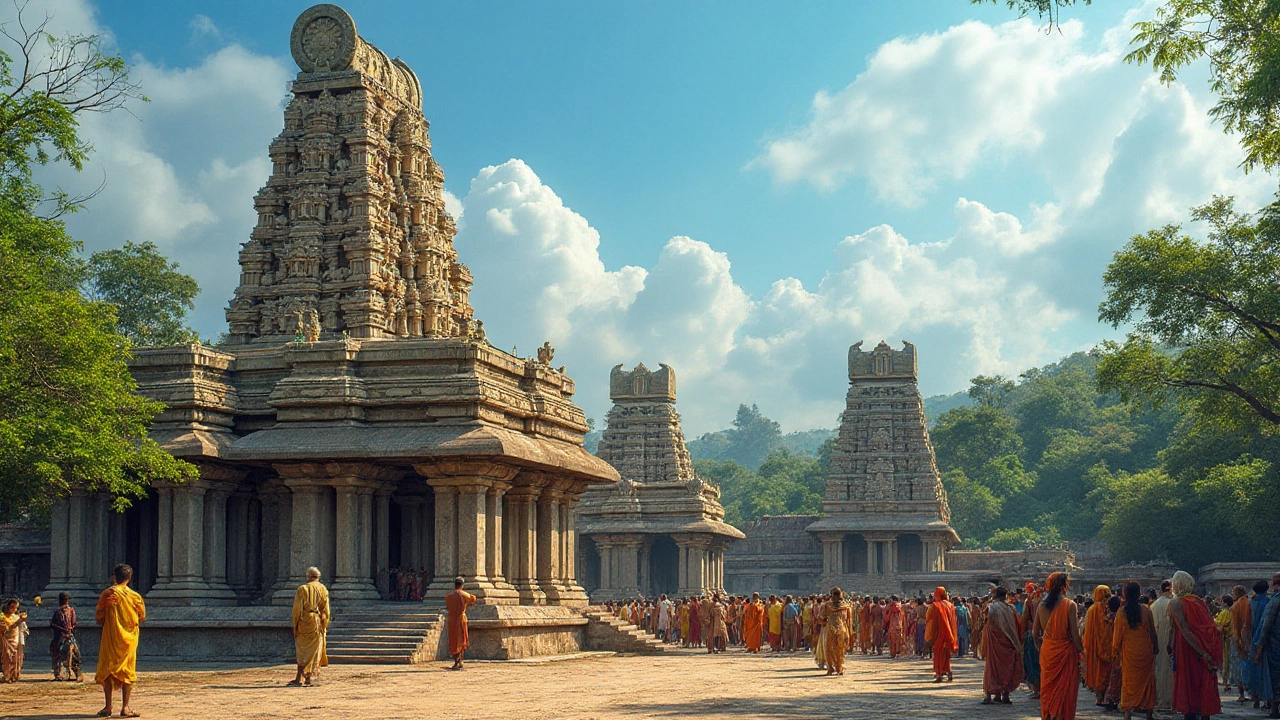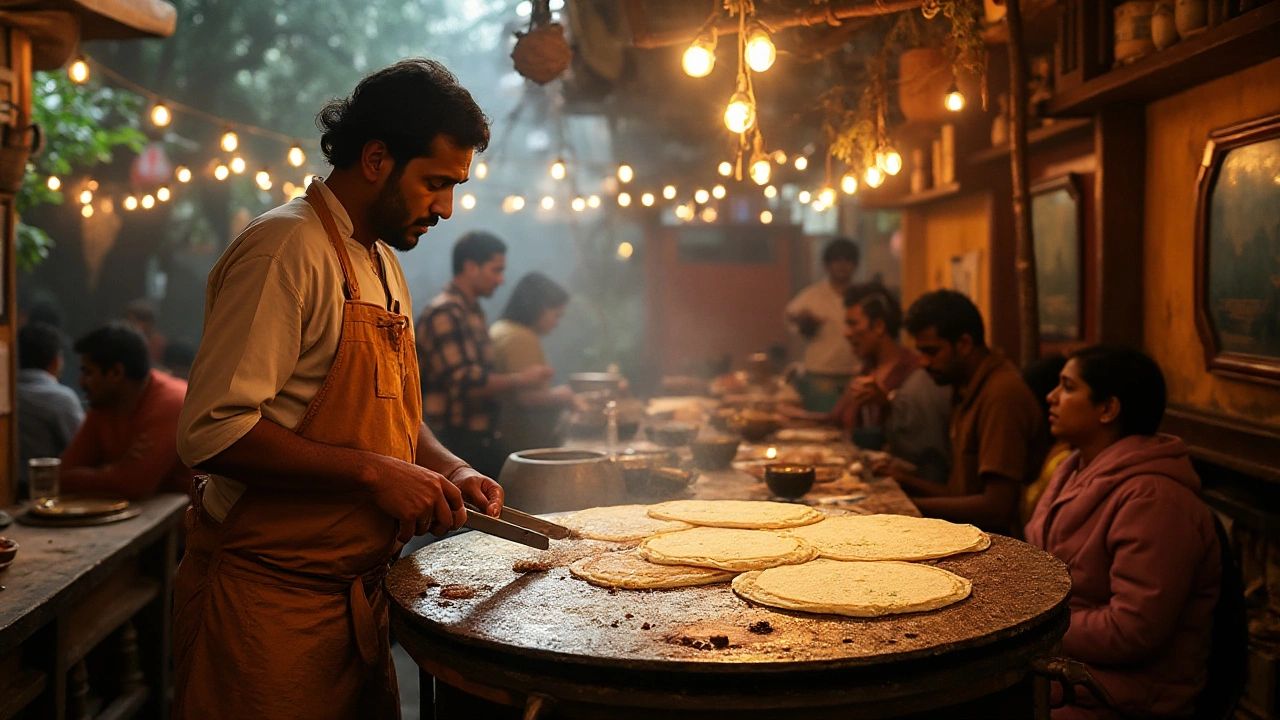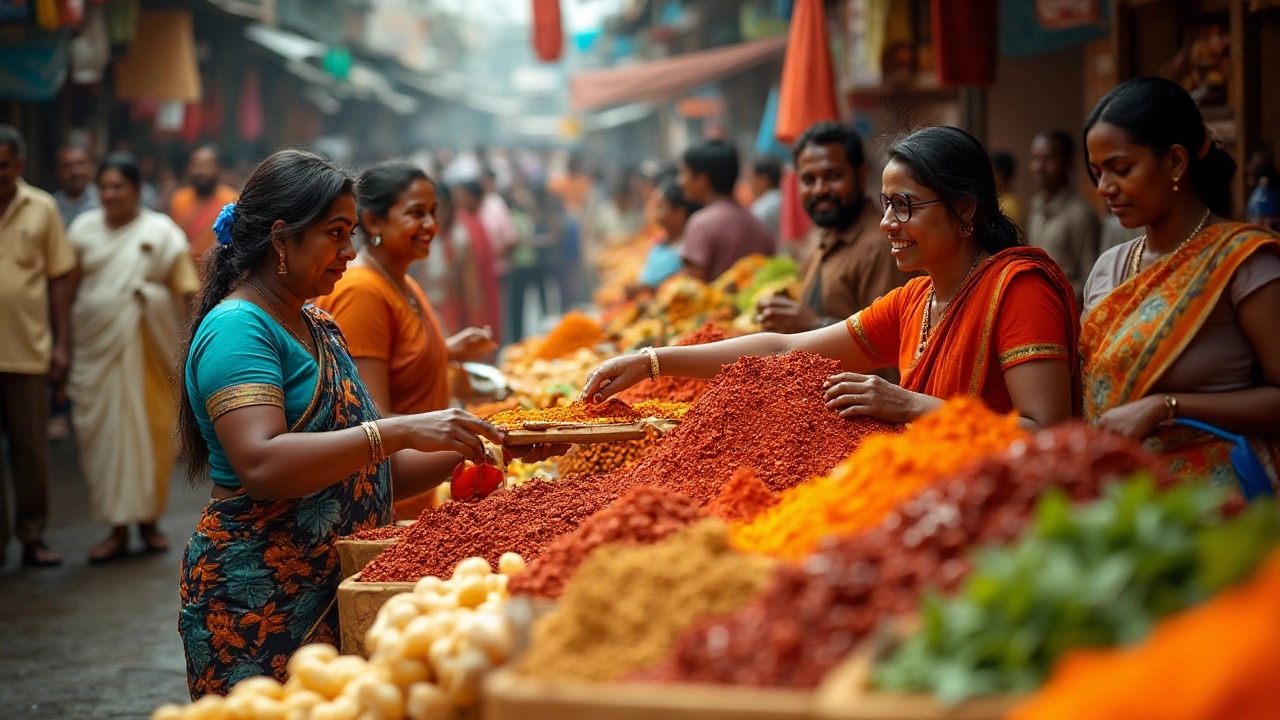Traveling to South India with a mere $100 in your pocket might seem like a challenge, but it can actually transform into an enriching adventure. The vibrant landscape of South India offers a fusion of scenic beauty, age-old traditions, and modern-day urban life, all accessible on a budget if you plan smartly.
Understanding how far this amount stretches in a place where the cost of living can be remarkably different from what you're used to is essential. Knowing which experiences are worth splurging on and which are best enjoyed at a minimal cost will be your key to unlocking the bounties of this beautiful region.
- Understanding the Exchange Rate
- Cost of Accommodation
- Exploring Local Cuisine
- Transport Options on a Budget
- Sightseeing and Attractions
- Tips for Smart Budgeting
Understanding the Exchange Rate
One of the first things to grasp when traveling with a budget of $100 in South India is the significance of the exchange rate. The Indian Rupee (INR) is the local currency, and its fluctuating value against the US dollar can greatly affect your spending power. For travelers, it is vital to stay informed about current exchange rates, which can usually be checked online or through various financial news outlets. As of late 2024, you can expect to get around 7,500 INR for $100, allowing you to stretch your budget significantly compared to some Western countries. This exchange rate can make travel in South India more accessible and enjoyable if navigated wisely.
The strength of your budget largely depends on how well you understand this exchange. Often, it might seem like a small difference, but even slight shifts can alter the cost of your entire stay. Currency exchange services are available at airports, hotels, and banks, but it's crucial to compare rates and determine the best deal. It's worth noting that airport exchanges might offer less favorable rates, so planning ahead by exchanging only a small amount upon arrival could save you money in the long run.
The cost of daily expenses such as food, transport, and activities varies significantly compared to many countries. Prudent management of your expenses begins with awareness of how exchange rates impact your purchasing power. For example, a simple yet sumptuous meal might cost around 200 INR, which is just a small fraction of your budget. Effectively managing the exchange rate enables you to experience more for less, as you'll soon appreciate the value of your dollar.
For a more in-depth look, it's fascinating to know how reserves and economic policies continuously influence exchange rates. According to Raghuram Rajan, former Governor of the Reserve Bank of India, "A stable exchange rate not only helps in maintaining balance in the economy but also encourages seamless trade and consistent foreign investments." This insight allows one to appreciate how infrastructure improvements and market stability foster affordable travel experiences in vibrant regions like South India.
Moreover, South India's hospitality industry thrives on offering both luxury and budget-friendly options. Tourists with a good grasp of current exchange rates benefit from being able to identify cost-efficient options for both accommodation and experiences. Budget accommodations are plentiful and surprisingly comfortable, especially if you have a keen eye for online deals. Likewise, understanding the importance of the exchange rate can optimize your experience, ensuring that your $100 maximizes its potential while immersed in the vibrant culture of South India.
Cost of Accommodation
Finding a place to lay your head for the night in South India without burning a hole in your wallet is more than achievable. This region offers a wide range of accommodation options catering to different needs and budgets—from bustling hostels filled with fellow travelers to serene homestays providing a taste of local hospitality. One can easily secure a dorm bed in backpacker hostels for a mere ₹400-₹700, which translates to $5-$9, allowing the budget traveler to extend their stay while having enough left for other experiences.
If you prefer a little more privacy but still wish to stick to your budget, numerous budget hotels provide private rooms starting at around ₹1000, roughly $12. These rooms often come with basic amenities such as Wi-Fi and breakfast, ensuring a comfortable stay without excess spending. Homestays offer another enriching alternative, allowing guests to experience daily South Indian life firsthand, with prices starting similarly.
"Homestays in India have become increasingly popular, providing travelers with an authentic experience while supporting local communities," notes Lonely Planet.
Luxury is redefined in India, where three-star comfort hotels present themselves as solid choices for the discerning traveler who doesn't want to overspend. Accommodation costs here are often surprisingly reasonable, with stays starting at approximately ₹2,500—just around $30—for well-furnished rooms, unquestionably a bargain by Western standards. Some places even offer complimentary guided tours, adding immense value to a traveler's journey. These options cater to varied preferences, making South India travel accessible to both penny pinchers and those willing to splurge a little.
For those keen on unique experiences, South India has several eco-lodges beautifully nestled in lush surroundings or coastal areas. Their prices vary depending on location and offerings, but budget travelers can find options at approximately ₹1500 ($18) per night. While the charm and comfort are undeniable, these lodges often actively promote sustainable travel practices, allowing visitors to contribute to environmental preservation.
Before booking any stays, it's advisable to read reviews on platforms like TripAdvisor or Booking.com to ensure quality and satisfaction. Being aware of your needs and aligning them with your budget will help in choosing the right accommodation, ensuring a fulfilling experience in India.

Exploring Local Cuisine
In the vibrantly diverse tapestry of South India, food plays a pivotal role in defining its cultural identity. A journey through this region is incomplete without indulging in its local cuisine, where flavors and aromas dance harmoniously, offering a delightful experience to even the most discerning palates. From the tantalizing spices of a traditional Chettinad curry to the aromatic scent of freshly prepared sambar, each dish introduces you to another facet of South Indian heritage. Embarking on a culinary expedition allows travelers to dive deep into an array of regional specialties, each a testament to the area’s agricultural wealth and historical influences.
An indispensable part of any visit to South India is savoring a hearty plate of dosa, a fermented crepe made from rice batter and black lentils. Dosas come in myriad variations, from plain to masala-stuffed, and are typically served with coconut chutney and sambar, a staple spicy lentil soup. For those with a sweet tooth, a serving of payasam, a creamy dessert cooked with jaggery and rice, is bound to satisfy. Interestingly, street food here is as much about flavor as it is about community and gathering. It’s said, "Food is not just eating energy, it's an experience," a quote often attributed to chef Guy Fieri, captures the sentiment behind every impromptu meal shared at roadside stalls.
Beyond individual dishes, dining customs in South India offer a unique charm. Meals are often served on banana leaves which adds a subtle flavor to the food while being environmentally sustainable. The quintessential South Indian thali, a round platter filled with small portions of various dishes, presents a holistic taste of the region. A standard thali includes rice, dal, vegetables, chapati, curd, pickles, and papadum, and offers great value for money, which fits perfectly in a budget traveler's plan. This approach of sampling across tastes and textures ensures that no culinary stone is left unturned during your visit.
To make the most of your culinary journey in South India, it's wise to dive into local eateries and cafes rather than high-end restaurants. Not only will you have a more genuine taste of the land, but it will also keep your expenses in check. With so much emphasis on vegetarianism due to cultural and religious practices, many traditional South Indian dishes emphasize vegetables and lentils, making them affordable and easily accessible. Flavors are defined by the generous use of spices like turmeric, mustard seeds, curry leaves, and tamarind, giving each dish its unique place in the vast culinary landscape. For seafood enthusiasts, the coastal regions offer mouth-watering dishes with freshly caught supplies that test the boundary between land and sea.
As you navigate through the culinary lanes of South India, keeping track of your budget need not take away from the indulgence. Through thoughtful choices, like opting for local meals and embracing regional practices, $100 can buy more than just a week’s worth of meals but lasting memories of warmth and community. An affordable luxury, exploring local cuisine offers an enriching taste of South India’s soul, feeding both body and spirit. South India travel becomes a broader canvas when flavors speak an enriching dialect of culture and tradition.
Transport Options on a Budget
India's transport network is as varied as its landscape, providing numerous options to explore the vibrant lands of South India without breaking the bank. Among the most economical ways to travel is the extensive train network, often hailed as the heart of Indian transportation. Trains not only offer affordability but also an authentic experience of mixing with locals. With a $100 budget translating to approximately ₹7,500, you could embark on several journeys across states, indulging in scenic views from your train window.
For intra-city travel, auto-rickshaws, the buzzing three-wheelers of India, make for an adventurous and cheap ride. Negotiating the fare is part of the experience in most cities, and it's always wise to settle on a price before hopping in. Metropolises like Chennai and Bangalore have modern metro systems that make navigating the city's vastness painless and even enjoyable. The metro is often the fastest mode to zoom past frenetic city traffic while keeping the journey light on your wallet.
If you're venturing between cities, government-operated buses offer an unbeatable blend of affordability and reach. Covering even the most remote destinations, government buses ply every corner, ensuring that tourists can travel smoothly. For added comfort and slightly higher pricing, various private bus services provide sleeper options, allowing you to save on accommodation costs by traveling overnight. A crucial piece of advice: book bus and train tickets online in advance through official sites or apps to snag the best deals and seats.
Highlighting the Value of Domestic Flights
India trip cost considerations suitably include budget airlines which have grown significantly in the country. If your itinerary includes long distances or you're pressed for time, airlines like IndiGo, SpiceJet, and AirAsia India offer competitively priced tickets, often on par with or cheaper than train fares for distant travel. Plan ahead and monitor fare alerts to take advantage of flash sales that slash ticket prices considerably. Checking in online and traveling with carry-ons can save additional fees, ensuring that flying can fit within your slender budget.
"An efficient public transport system is the fastening lifeline of any city's economy," states a report by World Bank India. Delhi Metro, a part of the national model, is celebrated for efficient connectivity and environmental benefits.
As you look to explore South India, consider renting a bicycle for sightseeing short distances in cities renowned for their relaxed pace, like Mysore or Pondicherry. Eco-friendly and extremely light on the pocket, bicycles provide freedom and flexibility while advocating a green enterprise. Additionally, joining a cycle tour can enrich your cultural tapestry, offering local insights and stories that are often bypassed in motorized travel.
Travel app aggregators have spruced up urban commutes, simplifying the process of finding rides, estimating costs, and ensuring safety, which is paramount for solo travelers. Ola and Uber operate widely in most major cities, often running promotions that can keep your travel expenses low.

Sightseeing and Attractions
When you think of South India travel, your mind instantly conjures up images of lush green backwaters, ancient temples, and bustling markets. Each corner of this vibrant region is steeped in cultural richness and historical marvels. Among the best places you must explore is the city of Hyderabad, home to the stunning Charminar and the regal Golconda Fort. These historical sites not only narrate tales of bygone eras but also offer panoramic views of the surrounding cityscape. Imagine walking through corridors once tread by kings and feeling the cool breeze atop ancient ramparts—it's an experience that history buffs would find hard to resist.
For nature lovers, Kerala's backwaters provide a serene escape. Hire a local houseboat and drift languorously on the tranquil waters, sipping on refreshing tender coconut. As you navigate through the network of lagoons, lakes, and canals, soak in the verdant surroundings dotted with swaying palm trees. This tranquil experience is unlike any other and doesn't require a heavy wallet. Many travelers visiting the region have remarked on the tranquility it evokes. As one traveler noted,
“Floating lazily amidst the backwaters is a meditative experience that remains with you long after you leave.”
Also noteworthy for visitors is the temple town of Madurai. Famous for the Meenakshi Amman Temple, this spiritual site is revered for its stunning architecture. Intricate carvings adorn the temple gopurams, and the colorful murals inside narrate stories of deities in vivid detail. Walking through these sacred corridors instills a sense of calm and reverence. Many people visit during the Chithirai Festival to witness the temple in all its festive glory—a celebration of culture that draws visitors from across the globe.
For those who crave a glimpse of the wilderness, a trip to Periyar National Park should top your list. With a mixture of evergreen and moist deciduous forests, the park offers exciting opportunities to spot wildlife such as elephants, tigers, and exotic bird species. A boat ride on Periyar Lake, especially at sunrise or sunset, increases your chances of spotting these magnificent creatures in their natural habitat. It's not just a feast for the eyes but also an educational experience on the conservation efforts preserving these vital ecosystems.
Coastal Gems and Hill Stations
The beaches of Goa and the hill stations of Ooty and Munnar highlight the Indian rupees value when allocated wisely. In Goa, miles of sandy beaches and azure waters create an ideal setting for leisure and relaxation. Whether it's the lively atmosphere of Baga Beach or the tranquil beauty of Palolem, there's something for everyone. Be sure to sample the local seafood—an indulgence that's surprisingly light on your wallet compared to many seaside resorts worldwide.
Meanwhile, the hill stations provide a welcome respite from the heat. Ooty, often dubbed the 'Queen of Hill Stations', offers cool climes and sprawling tea gardens. A ride on the Nilgiri Mountain Railway, a UNESCO World Heritage Site, is a delightful journey amidst scenic vistas of misty mountains and lush valleys. Similarly, Munnar’s tea plantations and Eravikulam National Park add an element of adventure and exploration that appeals to both families and solo travelers alike.
Remember, smart budgeting and planning during your South India sojourn can keep your expenses well within a $100 mark. Strategize visits to several free or low-cost attractions while opting for economical transportation and local eateries. This allows you to experience incredible diversity and richness without financial strain. South India, with its cornucopia of experiences, awaits anyone bold enough to explore it with an adventurous spirit and a humble budget.
Tips for Smart Budgeting
Navigating the diverse landscape of South India on a tight budget requires a strategy that's both clever and adaptable. It's all about knowing where to spend and where to save, a balance that can make your <$100 go surprisingly far. Begin by recognizing the local currency exchange rates and always carry a mix of cash and cards. In bigger cities like Bangalore or Chennai, ATMs are readily available, but in more remote areas, cash is king.
Accommodation is a major slice of your budget, but it doesn't have to break the bank. Opt for staying in budget hostels, guesthouses, or even homestays, which not only cut costs but also provide an opportunity to engage with locals and gain authentic insights into their cultures. Many travelers vouch for this approach, as succinctly put by Lonely Planet, "Staying with locals isn't just economical, it deepens your travel experience."
Let's delve into dining: South Indian cuisine is not only diverse and delicious but also extremely budget-friendly. From flavorful idlis and dosas to mouth-watering biryanis, street food and local eateries offer meals that tantalize your taste buds without making a dent in your wallet. Remember, it's often these small, tucked-away eateries that serve the most authentic flavors, allowing you to savor the real taste of India. Always choose fresh and cooked food to ensure hygiene.
Transport costs can be another drain on your budget, but with a little planning, it doesn't have to be. Public transport in South India is quite efficient. Buses and trains are not only economical but also offer a glimpse into daily life. Ride-sharing apps like Ola and Uber offer affordable and convenient options in major cities, while auto-rickshaws allow for quick trips at a bargain price. Always agree on a fare beforehand when using a rickshaw to avoid being overcharged.
Consider your leisure expenses carefully. Many of India's most breathtaking sights are the temples, beaches, and natural wonders that cost either a small entry fee or nothing at all. Balance these inclusions with other paid attractions that might interest you. Visiting during cultural festivals can provide free entertainment and a deeper understanding of local traditions. Always keep an eye out for seasonal discounts at museums or events.
The essence of traveling under a tight budget lies in wisdom and preparation. Planning your itinerary to combine free and paid activities is one essential strategy. Another is engaging with local communities who can provide insights into lesser-known spots and cost-effective options. For the digitally savvy, several apps and websites offer discounts and cashback on certain services, helping you make the most of every rupee. Establish a daily budget, and try to stick to it, keeping ample room for spontaneity and surprises along the journey.
